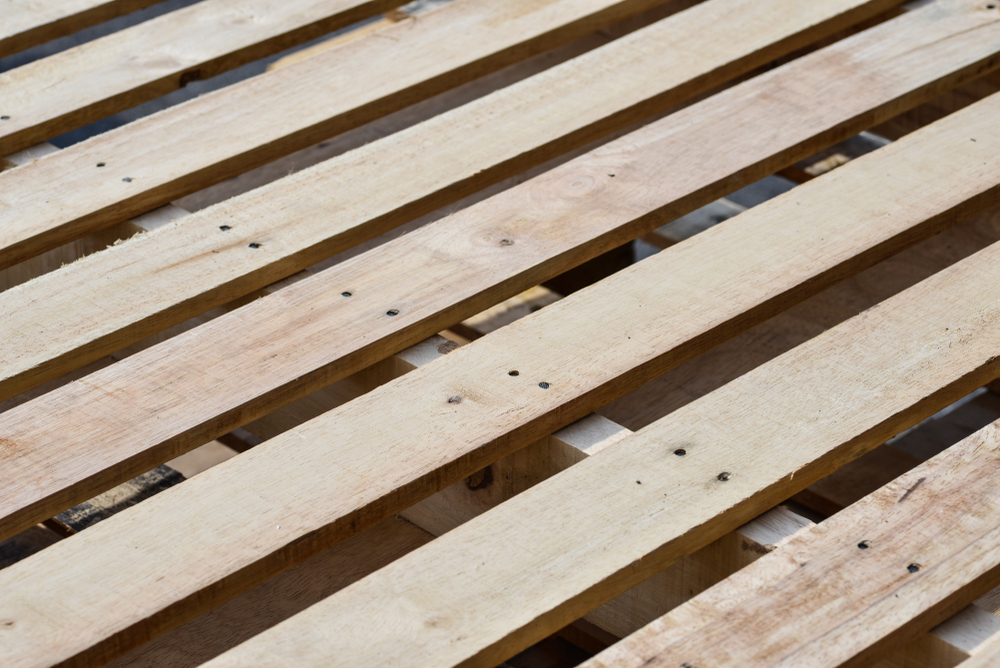New Timber Pallets vs. Used Pallets: What You Need to Know
If you are new to using timber pallets, you may be surprised that in some cases you are able to use used pallets. But if you aren’t aware of what to look for, you may end up getting inappropriate pallets that are unsafe.
In this guide, we discuss new timber pallets vs used pallets: what you need to know. All whilst providing supplementary information to help you find the best solutions, and the answers you need.
A and M Pallets Ltd is an established and respected supplier and producer of a wide array of pallets. Our services are designed to provide many industries with safe, strong and superior pallets of many varieties.
Our solutions are sure to help those in need of pallets for all sorts of logistical needs. We provide full pallet delivery and collection services in Cornwall, Devon, Somerset, Dorset, Wiltshire, and Avon.
How are used pallets safe if they have already been used?
While used pallets can be a cost-effective and sustainable option, it’s essential to handle them with care. Several factors contribute to potential safety risks. These factors are checked in detail before a used pallet is cleared to be used again.
Contamination
- Chemical residues: Pallets may have come into contact with hazardous materials during transportation.
- Biological contaminants: Food products, pests, or diseases can be present.
Structural Integrity
- Wear and tear: Over time, pallets can become damaged, weakened, or broken.
- Improper repairs: Incorrectly repaired pallets may fail under load.
Safety Measures
To mitigate these risks, it’s crucial to:
- Inspect pallets thoroughly: Check for signs of damage, contamination, or pests.
- Clean pallets: Wash or sanitize pallets before use, especially if intended for food contact or indoor applications.
- Prioritise source: Obtain pallets from reputable suppliers with established cleaning and inspection processes.
- Avoid pallets with hazardous material markings: These pallets should be disposed of properly.
- Consider pallet heat treatment: This process kills pests and reduces the risk of contamination.
By following these guidelines, you can significantly reduce the risks associated with using used pallets.
OSHA Rules for Pallets
While OSHA doesn’t have a specific standard dedicated solely to pallets, it does cover pallet safety under broader regulations related to material handling and storage.
Key OSHA Regulations Affecting Pallet Safety:
- 176(b) Storage of Materials: This standard requires that materials, including pallets, be stored in a way that prevents hazards like collapse or sliding.
- 14 Stacking of Cargo and Pallets: Specifically for marine terminals, this standard mandates that cargo and pallets be stacked securely to prevent accidents.
General Pallet Safety Guidelines Based on OSHA Principles:
- Proper stacking: Pallets should be stacked evenly and securely to prevent collapse.
- Avoid overloading: Pallets should not be overloaded, as this can lead to structural failure.
- Inspect pallets regularly: Damaged or worn pallets should be repaired or discarded.
- Safe handling: Use appropriate equipment, such as forklifts, to handle pallets.
- Employee training: Workers should be trained in safe pallet handling and storage practices.
Remember: While these guidelines are based on OSHA principles, specific industry regulations and local laws might have additional requirements. It’s essential to consult with your local OSHA office or industry-specific safety standards for complete information.
New timber pallets vs use pallets: what you need to know

The choice between new and used timber pallets can significantly impact a business’s operations, costs, and environmental footprint. Here is when each of these options are generally used:
- New pallets: Necessary for industries with stringent hygiene standards, when consistent quality is paramount, or for export where specific pallet treatments are required.
- Used pallets: Necessary for cost-sensitive businesses, those prioritising sustainability, or when immediate pallet availability is crucial.
Let’s delve into the pros and cons of each option:
New Timber Pallets
Pros
- Consistent quality: New pallets are manufactured to specific standards, ensuring uniformity in size, weight, and strength.
- Hygiene: New pallets are free from contaminants, making them ideal for food and pharmaceutical industries.
- Brand image: For businesses prioritising a clean and professional image, new pallets can enhance perception.
- Traceability: Often, new pallets have a clear origin, making them easier to trace in case of issues.
Cons
- Higher cost: New pallets are generally more expensive than used ones.
- Environmental impact: The production of new pallets requires resources and energy.
- Lead time: There might be a delay in obtaining new pallets, especially during peak demand.
New timber pallets are used for:
- Food and pharmaceutical industries
- High-end retail and luxury goods
- Export and import operations requiring specific pallet standards
- Businesses with strict quality control measures
Used Timber Pallets
Pros
- Cost-effective: Used pallets are significantly cheaper than new ones.
- Sustainability: Reusing pallets reduces waste and conserves resources.
- Availability: Used pallets are readily available in most regions.
Cons
- Variable quality: Condition can vary widely, with potential for damage, pests, or contamination.
- Hygiene risks: Used pallets may harbour contaminants, making them unsuitable for certain industries.
- Safety concerns: Damaged or weak pallets pose safety risks.
- Traceability: Determining the origin and history of used pallets can be challenging.
Used timber pallets are used for:
- Industries with less stringent hygiene requirements (e.g., manufacturing, construction)
- Businesses with a focus on cost reduction
- Companies with robust quality inspection processes
- Environments where pallet lifespan is relatively short
Additional considerations:
- Pallet repair: Many businesses opt to repair used pallets to extend their lifespan and improve quality.
- Pallet pooling: This involves renting pallets from a pool, providing a balance between cost, quality, and sustainability.
- Alternative materials: Consider plastic or metal pallets for specific applications, such as export or heavy-duty use.
By carefully evaluating these factors, businesses can select the most appropriate pallet type to meet their specific needs and objectives.
Are there any downsides to using pallets?

While pallets are essential for efficient logistics, they do present certain challenges. Primarily, wood pallets are susceptible to damage, contamination, and decay.
Their structural integrity can deteriorate over time, leading to safety hazards such as splintering or collapse. Additionally, wood is a porous material, making it difficult to clean and sanitize, particularly for industries handling food or pharmaceuticals.
Another concern is the environmental impact of sourcing timber for pallet production. Although recycled pallets can mitigate this, there’s still a demand for new wood. Finally, the weight of wooden pallets can impact transportation costs, especially for long-distance shipments.
Is it better to use non-wood pallets?
Non-wood pallets, primarily plastic and metal, offer several advantages over traditional wooden pallets:
- Hygiene: Plastic and metal pallets are non-porous, making them easier to clean and sanitize. This is crucial for industries handling food, pharmaceuticals, or chemicals.
- Durability: Non-wood pallets are generally more resistant to damage, pests, and weather conditions, leading to a longer lifespan.
- Sustainability: While the initial production of plastic pallets might have a higher environmental impact, their reusability, and recyclability can offset this over time. Metal pallets, being highly recyclable, are generally considered more environmentally friendly.
- Weight: Non-wood pallets are often lighter, reducing transportation costs and improving handling efficiency.
- Safety: Without nails or splinters, non-wood pallets pose fewer safety risks to workers.
However, it’s important to note that non-wood pallets also have drawbacks. They are generally more expensive than wooden pallets, and their availability might be limited in some regions. Additionally, while plastic pallets are recyclable, the recycling process can be complex and costly.
How to order a used or new timber pallet

The easiest way to order new timber pallets for your needs, and to your specification, is by contacting A and M Pallets Ltd.
A and M Pallets Ltd is a leading supplier of various pallets for over 30 years. We know many of our customers have unique needs, this is why we cater specifically towards your exact preferences. We have the ability to design and manufacture almost anything you can ask for in a pallet. So what makes us special?
We cater to any quantity:
Need one pallet or a thousand? We’ve got you covered. For complete peace of mind, we offer samples so you can experience our premium craftsmanship first hand before committing to a large order.
Sustainability matters:
We source only virgin wood stock from the most responsible suppliers in the UK, supporting local sawmills and promoting environmentally conscious practices throughout our industry.
Experience the A&M difference:
Our time-tested production and delivery process ensures a smooth experience, getting you the high-quality pallets you need, exactly when you need them.
Find the best timber pallet for you today

As the South West’s largest independent producer and supplier of new and reconditioned pallets, we at A and M Pallets Ltd pride ourselves on providing unrivalled services and the best possible pallets since 1989.
Our hard work, in addition to our loyal and ever-expanding customer base, has allowed us to provide comprehensive coverage through the South West and further afield though our four sites in St. Austell, Tavistock, Launceston and Willand.
Producing over 45,000 pallets a month, you can be sure we will have what you are looking for, whether it is used pallets, new pallets, plastic pallets or ISPM15 heat treated pallets, we are here to help.
In this guide, we hope to have shown you what you need to know about new timber pallets vs used timber pallets. Whilst providing helpful additional information, including our unparalleled services. Our expert team is here to help you on each step of your journey with us, for more information, you can contact us here, or find us below at:
Head Office:
- Unit One Northcott Hamlet
- Launceston
- Cornwall
- PL15 9RQ
- T: 01409 211386
- E: admin@aandmpallets.co.uk
- Mon – Fri: 9am to 5pm
Austell Office:
- Brighton Cross
- Grampound Road
- Truro
- Cornwall
- TR2 4HD
- T: 01726 882122
- E: info@aandmpallets.co.uk
- Mon – Fri: 8am to 5pm
Tavistock Office:
- Haye Down Ind. Est.
- Chillaton
- Tavistock
- Devon
- PL19 0NN
- T: 01822 860456
- E: info@aandmpallets.co.uk
- Mon – Fri: 7am to 5pm
Willand Office:
- 5 Willand Rd Bus. Park
- Willand Road
- Willand
- Devon
- EX15 2RF
- T: 01884 841942
- E: info@aandmpallets.co.uk
- Mon – Fri: 8.30am to 4.30pm
